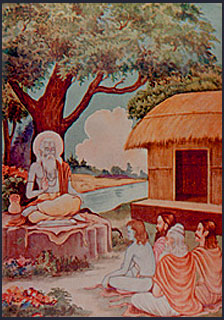
“Guru Brahma Guru Vishnu Gurudeva Maheshwara
Guru Sakshat Para Brahman
Tasmay Sri Guruve Namah”
The Guru is the Eternal Supreme Being
We offer our salutations to the Guru
The full moon day of Ashad, falling on Wednesday 13th July 2022, and on Monday 3rd July in 2023, is celebrated as Guru Purnima, in honour of the birth of Maharishi Veda Vyasa. Sri Vyasa compiled and codified the four Vedas – Rig Veda, Yajur Veda, Atharva Veda and Sama Veda. He authored the Brahma Sutras, which contain the essence of Vedanta.
He is the compiler of the Puranas in every age; for this age, he is Krishnadvaipayana, son of Parasara. He wrote the eighteen Puranas, including the deeply devotional Srimad Bhagavata, through which laymen could be inspired by the lofty principles of the Vedas, through the medium of legends. He wrote the epic, Mahabharata. To Sri Veda Vyas, we offer our pranama. And to all enlightened beings whose blessings we seek on the path of Self Knowledge, the path of Divine Wisdom.
The four months of Chaturmas begins with Guru Purnima, when aspirants make a fresh resolve to intensify their spiritual practices. For those who have dedicated themselves to spiritual life, the monsoon months are essentially a period of retreat marked by the study of the sacred texts, especially the Prasthaan Threya, or triple foundation of Brahma Sutras, Upanishads and Gita. In the Uttara Mimamsa of the Sutras, Veda Vyasa writes: Athatho Brahma Jigyasaa indicating the importance of the search for knowledge of Brahman or the Absolute. Accordingly, this time is devoted with renewed vigour, to sadhana or spiritual practice, japa and meditation.
On Guru Purnima, spiritual aspirants and devotees perform Vyasa Puja and disciples worship their guru or spiritual preceptor. Saints are honoured with dakshina (offerings) offered with faith and respect. A restricted diet of milk and fruit is recommended for the day. Traditionally, the day begins at Brahmamuhurta (before 4 a.m.) with japa and meditation. Vyasa Puja and/or worship of the guru is performed. The day is spent in meditation, study of the Scriptures and satsangha with spiritual discourses, bhajans, etc. It is believed that practices of meditation, japa or mantra recitation, seva or selfless service and dakshina or offerings, performed on this day are extremely auspicious in connecting us with the power bestowed through grace and blessings.
To be a worthy seeker of Brahma Vidya or the Highest Knowledge, one must be an adhikari, that is have yogyata or readiness denoted by the right attributes and qualities for spiritual knowledge which are considered imperative. Spiritual aspirants are expected to have the following qualities:
vivek – discrimination between the Real and the Unreal, the transient, changing and the unchanging Eternal
vairagya – dispassion, detachment, renunciation that arises from vivek
satsampat or six fold virtues of:
1. sama – restraint of mind, equanimity
2. dama – control of senses
3. upparati – contentment and state of desirelessness that is a result of viveka,
vairagya, sama and dama
4. titiksha – forbearance, tolerance, equanimity in the face of the pairs of
opposites of pleasure and pain, heat and cold, etc.
5. shraddha – perfection of faith
6. samadhana – focused concentration and ability to focus on Brahman with
total poise, indifference to all states, neither attraction nor repulsion
mumukshatva – intense desire for liberation.
A sadhak or spiritual aspirant should continuously be in higher states of contemplation, reflection and meditation. Through Sravana or hearing of the Scriptures, Manana or contemplating and reflecting on them, Nididhyasana or constant and profound meditation, the aspirant is graced with Atma-Sakshatkara or direct experience of the Truth.
The Sun (Surya) is the visible symbol of the Supreme (Narayana) and is therefore known as Surya Narayana. The full moon reflects perfectly the light of the illuminating Sun. The moon is also symbolic of the mind. When the mind is purified it reflects the Atman. Purification is attained through selfless service and through spiritual sadhana. On the full moon of Guru Purnima, aspirants seek and pledge to purify their mind to reflect the glory of the Sun in all its splendour.
“Dhyaana moolam guror murtih;
Pooja moolam guror padam;
Mantra moolam guror vakyam;
Moksha moolam guror kripa”
~ Guru Vandana
The form of the Guru is worthy of meditation
Offer worship at the feet of the Guru
The words of the guru are mantras indeed
Liberation is by the grace of the Guru.
The Guru of Gurus, Avadhuta Dattatreyaya is the son of Saptrishi Atri Muni and Ansuya Mata, the embodiment of perfect womanhood. He is worshipped as Brahma-Vishnu-Mahesh in One. Regarding Nature as his Guru, he spoke of his 24 Gurus, from each of whom he received knowledge. In transcending the Panch tattwas or elements, from the earth he learnt patience and forbearance, from the waters he learnt purity, from fire he learnt tapas (austerity) and self-knowledge, from the air he learnt to move without attachment, from the sky he learnt that the self is all-pervading. From the moon he learnt that the Self is eternal and unchanging, and it is only the mind that moves. From the Sun he learnt the Nature of Brahman and the nature of Duality. Pranama to Bhagwan Dattatreyaya.
The Siddhas are enlightened beings, the embodiment of perfection. The Puranic and philosophical background about Siddhas is as old as the Vedas themselves, which are regarded as given by Sri Narayana to Lord Brahma and later narrated by Sri Veda Vyas. Lord Shiva is the fountainhead of Siddhas and the 9 Naths and 84 Siddhas are immortal forms or mayic manifestations of Shiva himself. Nath denotes both the Creator and the all-Knower. Nath has been referred to in the Atharva Veda as the Eternal. Nath Tattwa refers to the Supreme and brings moksha or liberation, dispels darkness as the Satguru, brings freedom from ignorance and is an indication of Brahma. Pranama to the Nine Naths and 84 Siddhas.
On Guru Purnima, we affirm our belief in the Eternal Truth, and our faith in the scriptures and teachings that have been brought to humanity through the great immortal seers who guide the evolution of consciousness. May we be blessed to seek Brahma Vidya (Supreme Knowledge). May our minds be purified and our hearts open so that we may be adhikaris or deserving of spiritual knowledge and may the sanctity of the sacred teachings be preserved by us.


Leave a Reply